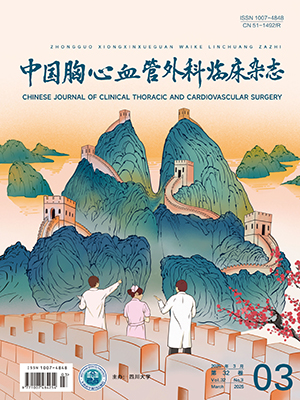| 1. |
Stern HJ. Fontan "Ten Commandments" revisited and revised. Pediatr Cardiol, 2010, 31(8):1131-1134.
|
| 2. |
Hosein RB, Clarke AJ, McGuirk SP, et al. Factors influencing early and late outcome following the Fontan procedure in the current era. The ‘Two Commandments’? Eur J Cardiothoracic Surg, 2007, 31(3):344-353.
|
| 3. |
Petit CJ. Staged Single-ventricle palliation in 2011:outcomes and expectations. Congenit Heart Dis, 2011, 6(5):406-416.
|
| 4. |
Stern HJ. Aggressive coiling of aortopulmonary collaterals in single-ventricle patients is warranted. Pediatr Cardiol, 2010, 31(4):449-453.
|
| 5. |
吴清玉, 张明奎, 李洪银, 等. 分期全腔静脉-肺动脉连接术治疗复杂先天性心脏病. 中华外科杂志, 2009, 47(7):530-533.
|
| 6. |
Bridges ND, Jonas RA, Mayer JE, et al. Bidirectional cavopulmonary anastomosis as interim palliation for high-risk Fontan candidates. Early results. Circulation, 1990, 82 (5 Suppl):IV170-IV176.
|
| 7. |
Trusler GA, Williams WG, Cohen AJ, et al. The cavopulmonary shunt. Evolution of a concept. Circulation, 1990, 82 (suppl IV):IV131-IV138.
|
| 8. |
Pridjian AK, Mendelsohn AM, Lupinetti FM, et al. Usefulness of the bidirectional Glenn procedure as staged reconstruction for the functional single ventricle. Am J Cardiol, 1993, 71(11):959-962.
|
| 9. |
Masuda M, Kado H, Shiokawa Y, et al. Clinical results of the staged Fontan procedure in high-risk patients. Ann Thorac Surg, 1998, 65(6):1721-1725.
|
| 10. |
郑景浩, 徐志伟, 苏肇伉, 等. 二期Fontan 术治疗小儿复杂先天性心脏病. 中华胸心血管外科杂志, 2007, 23(2):97-99.
|
| 11. |
Backer CL, Deal BJ, Mavroudis C, et al. Extracardiac versus intraatrial lateral tunnel Fontan:extracardiac is better. Semin Thorac Cardiovasc Surg Pediatr Card Surg Ann, 2011, 14(1):4-10.
|
| 12. |
Jonas RA.The intra/extracardiac conduit fenestrated Fontan. Semin Thorac Cardiovasc Surg Pediatr Card Surg Ann, 2011, 14(1):11-18.
|
| 13. |
Kogon B. Is the extracardiac conduit the preferred Fontan approach for patients with univentricular hearts? The extracardiac conduit is the preferred Fontan approach for patients with univentricular hearts. Circulation, 2012, 126(21):2511-2515.
|
| 14. |
Khairy P, Poirier N. Is the extracardiac conduit the preferred Fontan approach for patients with univentricular hearts? The extracardiac conduit is not the preferred Fontan approach for patients with univentricular hearts. Circulation, 2012, 126(21):2516-2525.
|
| 15. |
Kreutzer C, Schlichter AJ, Simon JL, et al. A new method for reliable fenestration in extracardiac conduit Fontan operations. Ann Thorac Surg, 2003, 75(5):1657-1659.
|
| 16. |
Ocello S, Salviato N, Marcelletti CF. Results of 100 consecutive extracardiac conduit Fontan operations. Pediatr Cardiol, 2007, 28(6):433-437.
|
| 17. |
O'Brien JE Jr, Marshall JA, Young AR, et al. The nonfenestrated extracardiac Fontan procedure:a cohort of 145 patients. Ann Thorac Surg, 2010, 89(6):1815-1820.
|
| 18. |
Thompson LD, Petrossian E, McElhinney DB, et al. Is it necessary to routinely fenestrate an Extracardiac Fontan? J Am Coll Cardiol, 1999, 34(2):539-544.
|
| 19. |
Lemler MS, Scott WA, Leonard SR, et al. Fenestration improves clinical outcome of the fontan procedure:a prospective, randomized study. Circulation, 2002, 105(2):207-212.
|
| 20. |
朱宏斌, 郑景浩, 刘锦纷, 等. Fontan 术后顽固性胸腔积液相关因素分析及处理. 中华胸心血管外科杂志, 2005, 21(3):173-174.
|
| 21. |
Salazar JD, Zafar F, Siddiqui K, et al. Fenestration during Fontan palliation:Now the exception instead of the rule. J Thorac Cardiovasc Surg, 2010, 140(1):129-136.
|
| 22. |
Jonas RA, Castanada AR. Modified Fontan procedure:atrial buffle and systemic venous to pulmonary artery anastomotic techniques. J Card Surg, 1988, 3(2):91-96.
|
| 23. |
李世国, 蒋世良, 徐仲英, 等. 经导管封堵全腔静脉肺动脉连接术外管道开窗的初步临床应用. 中华心血管病杂志, 2008, 36(6):489-492.
|




